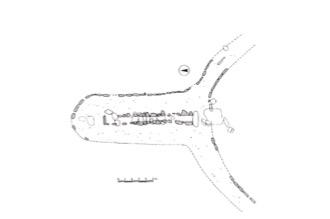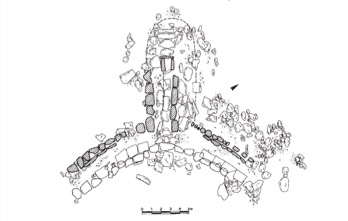The burial chamber in the giants’ tombs: examples from Dorgali and other parts of the island
The giants’ tomb, used by the Nuraghic people to bury their dead from the Middle Bronze Age (1600 B.C.), is characterised by a rectangular burial chamber with a semi-circular rear. The entrance to the tomb is located at the centre of the exedra’s large external ceremonial space.
The term "giants' tombs" was given by popular folklore which thought they contained the bodies of gigantic men because of the sometimes imposing dimensions of the monument.
The masonry techniques used for building the room are essentially two:
1. with orthostats, i.e. with large stones placed knife-wise into the ground, over which slabs of the same type were placed to form the roof;
2. with an isodomic structure, i.e. with stones positioned in regular horizontal rows. The higher rows narrow at the top so as to create a triangular cross section.
The orthostat type tomb, also called dolmen-type, in addition to Thomes, has also been found in S'Iscra 'e Lottoni, Sueredu, Abba Noa I (fig. 1) and San Basilio in the territory of Dorgali, and is in general widespread throughout central-northern Sardinia.

The second type, characterised by a greater masonry sophistication, includes the graves of Biristeddi I, Ena 'e Iloghe, S'Ulumu. This type is mainly concentrated in central-southern Sardinia.
The length of the chamber varies considerably: from the 16.50 m. in San Cosimo-Gonnosfanadiga to the 2.55 m. in Ruinachesos-Sorgono. Practical items for worship, such as niches and benches, could be found inside. The floor surface is paved by laying either mosaic-shaped flat scales or carefully arranged large shaped tiles.
The tomb of Biristeddi I-Dorgali (fig. 2), also known as “Sa Tumba de Su Re" has a rectangular burial chamber (length 8.00 m; width 1.20 m; residual height 1.80 m), made with large well-carved square blocks, arranged in regular rows.

(from MORAVETTI 1998, fig. 69, p. 82).
Tomb 2 in Iloi-Sedilo also falls in the category of row-type graves (fig. 3) as does the tomb of San Cosimo-Gonnosfanadiga, one of the largest known to date (fig. 4).


In many giants’ tombs, the materials which make up the grave goods are located outside the chamber. Sometimes, the reason for this arrangement of the grave goods is due to the clandestine looting of the tombs which occurred over the centuries.
Bibliografia
- CASTALDI E., Nuove osservazioni sulle Tombe di giganti, in Bullettino di Paletnologia Italiana, XIX, 77, 1968, pp. 7-91.
- CASTALDI E., Tombe di giganti nel Sassarese, in Origini, III, 1969, p. 134.
- DEPALMAS A., Alcune osservazioni su articolazioni e indicatori cronologici del Bronzo Medio in Sardegna, in BERNARDINI P. et alii, La civiltà nuragica. Nuove acquisizioni, Atti del Congresso (Senorbì 14-16 dicembre 2000), I, Quaderni, Quartu Sant’Elena 2005, pp. 129-141.
- DEPALMAS A., Il Bronzo Medio della Sardegna, in Atti della XLIV Riunione Scientifica. La Preistoria e la Protostoria della Sardegna, Firenze 2009, pp. 49-58.
- FERRARESE CERUTI M. L., Architettura e ceramica dell’Età del Bronzo in Sardegna, in ANTONA A. LO SCHIAVO F. (a cura di), Archeologia della Sardegna preistorica e Protostorica, Nuoro 1997, pp. 509-513.
- MANUNZA M.R., Dorgali. Monumenti antichi, Oristano, 1995.
- MORAVETTI A., Tombe di giganti nel Dorgalese, in Dorgali. Documenti archeologici, Sassari 1980, pp. 79-93.
- MORAVETTI A., Le tombe e l’ideologia funeraria, in La civiltà nuragica, Milano, 1990, pp. 120-168.
- MORAVETTI A., Serra Orrios e i monumenti archeologici di Dorgali, Sardegna Archeologica. Guide e itinerari, 26, Sassari 1998.

 VR
VR